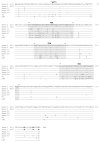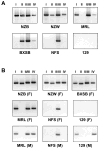Dissection of genetic mechanisms governing the expression of serum retroviral gp70 implicated in murine lupus nephritis
- PMID: 18684976
- PMCID: PMC2587122
- DOI: 10.4049/jimmunol.181.4.2846
Dissection of genetic mechanisms governing the expression of serum retroviral gp70 implicated in murine lupus nephritis
Abstract
The endogenous retroviral envelope glycoprotein, gp70, implicated in murine lupus nephritis is secreted by hepatocytes as an acute phase protein, and it has been thought to be a product of an endogenous xenotropic virus, NZB-X1. However, since endogenous polytropic (PT) and modified polytropic (mPT) viruses encode gp70s that are closely related to xenotropic gp70, these viruses can be additional sources of serum gp70. To better understand the genetic basis of the expression of serum gp70, we analyzed the abundance of xenotropic, PT, or mPT gp70 RNAs in livers and the genomic composition of corresponding proviruses in various strains of mice, including two different Sgp (serum gp70 production) congenic mice. Our results demonstrated that the expression of different viral gp70 RNAs was remarkably heterogeneous among various mouse strains and that the level of serum gp70 production was regulated by multiple structural and regulatory genes. Additionally, a significant contribution of PT and mPT gp70s to serum gp70 was revealed by the detection of PT and mPT, but not xenotropic transcripts in 129 mice, and by a closer correlation of serum levels of gp70 with the abundance of PT and mPT gp70 RNAs than with that of xenotropic gp70 RNA in Sgp3 congenic mice. Furthermore, the injection of lipopolysaccharides selectively up-regulated the expression of xenotropic and mPT gp70 RNAs, but not PT gp70 RNA. Our data indicate that the genetic origin of serum gp70 is more heterogeneous than previously thought, and that distinct retroviral gp70s are differentially regulated in physiological vs inflammatory conditions.
Figures



References
Publication types
MeSH terms
Substances
Grants and funding
LinkOut - more resources
Full Text Sources
Molecular Biology Databases

